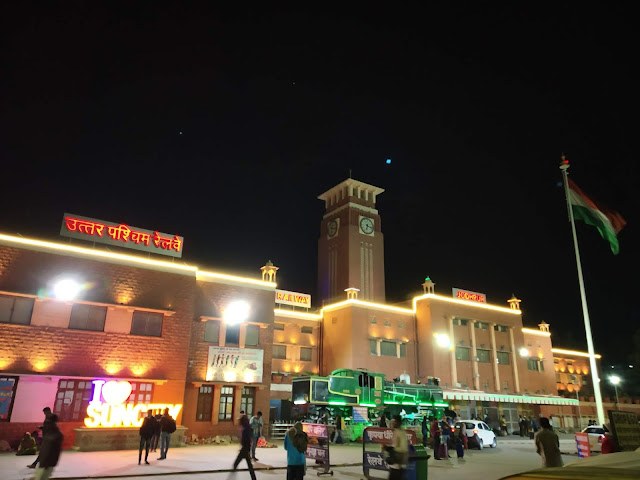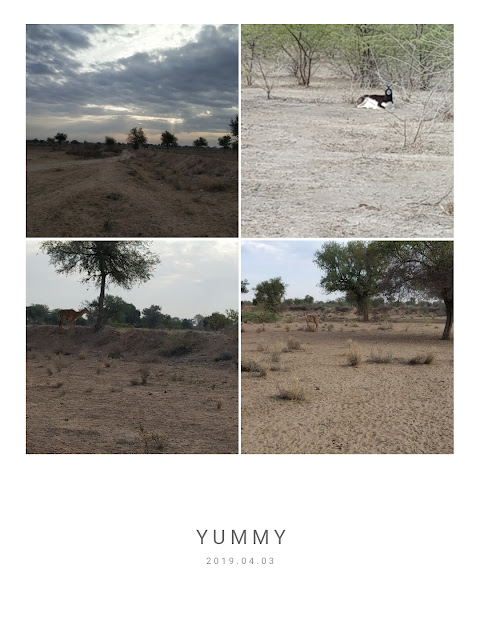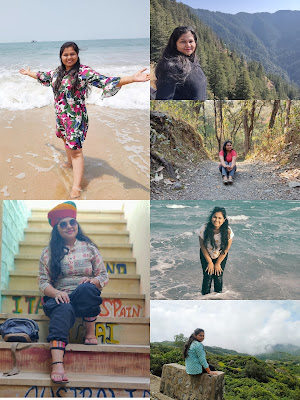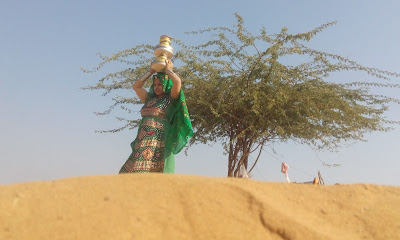A visit to the Bishnoi Sect....
Jodhpur is like any other Rajasthan town with its
step wells and Sandy terrain, historic forts and hospitable people, veritable
bazaars and vibrant life. But if you have a traveller's eye, it won't be hard to
find its unique character throbbing in myriad of ways.
As I arrived
at the railway station of the Blue City in a wintry morning at the break of
dawn, what had me in the grip of thoughts was the mesmerising art work.
The beautiful portrait of a climbing lady on the
stairs to the over-bridge connecting various platforms was a unique, to say the
least. Rajasthan has truly got something that attracts so much and never allows
the visitors to leave. The huge and intricate Rajasthani paintings on the walls
the station, people with Rajput moustaches wearing turban and serving tea in
the early morning, the neat and clean of the station serve you the real cultural taste of the desert state
as it offered you a warm welcome.
There is no doubt that Rajasthan is an all that
favourite tourist destination because of its unique cultural and rich heritage.
To taste this cultural flavour a drive to Bishnoi Village in Jodhpur is must.
“Bishnoi Village” is a titchy hamlet tucked in the rural environs, and located
at around 40 km from Jodhpur. The villagers are the true worshippers of nature.
In Bishnoi Village, one gets more than a glimpse of amazing cultural life of
Marwar – the original community of Rajasthan.
Like most names have a myth or some hidden facts
behind them, the Bishnoi village has its own share of intriguing tales behind
it. Long ago, in 1451, there came the term ‘Bishnoi’ to save the mother earth.
As we all know that in our early ages the Kings and Zamindars were very fond of
hunting which was also a kind of their status symbol. People started feeling
the loss of their wildlife and there arouse a group of members pioneered by
Guru Jambheshwar commonly known as Jambhore Babu, aimed to save the nature and
wildlife. Unlike Chipko Movement, Bishnoi is a sect, customs and rules under
which cutting of trees and destroying wildlife were completely banned. There is
a serious and a deep meaning after the name “Bishnoi” where “Bish” means, bees
(twenty) and “noi” means “nau”(nine), therefore when “bees” is added to “nau”
it becomes “untis”( twenty nine). So there were twenty nine rules to be
followed by the villagers under this sect.
Bishnoi are the people who have affection, harmony
and respect not only for human beings but also for Mother Nature, wild animals
and trees. The villagers are well-known for their eco-friendly attitude and
their efforts in preserving the flora and fauna of Rajasthan.
Salman Khan being tried for allegedly killing
blackbucks in Rajasthan may have brought to common knowledge the love the
Bishnoi community has for wildlife. Some sections in the country also tried to
defend Salman Khan by saying what is the big deal as Salman Khan has not killed
any human being to get such a harsh punishment. But I ventured into the village
early in the morning from Jodhpur in a jeep as part of the safari conducted by Om
Prakash of the Bishnoi village, I realised why and how they hold dear their
wildlife. After driving some 20 km on the highway, the veered into the
wilderness. Prakash was intent on showing me blackbucks, peacocks, rabbits,
Deer, gazzel, Nilgai, and host of other wildlife treasures through the detour.
Only Jeeps can negotiate the rough, Sandy
wilderness. This was no wildlife sanctuary or reserve and seeing them in the
natural setting was a rare feeling. I was thrilled to see a group is peacocks
near Gudha village chattering and screaming as if to know who has come to their
abode.
Peacock chattering and enjoying the early morning
I wandered in the wilderness for about half an hour
amidst the suspecting deers and unconvincing blackbucks and always-in-a-hurry
rabbits as Om Prakash would explain me their behaviour towards humans.
Bishnoi rural life:
There has been different corners in the village where
Bishnois show their own creative skills.
Potters:
Then the jeep drove me to Singhasni a Potter’s
village. The village is known for its finest works of pottery. I was amazed to
see their artistic work in statues, cups, houses, bells, lanterns, animals,
pots and many other items. Basically the process of making a pot is around a 22
days process.(name), the potter explained the different methods of his artistic
work.
I too applied
my hand and ideas in imitating his style.
Though it did not turn out to be that perfect but I was happy doing it.
The man also showed me the oven in which the pot is
prepared. It was not the oven which is commonly used at homes, whereas it was a
huge round circled pit, which can accommodate at least twenty people at a time.
After getting cooked in a deep-pit oven, the pot gets ready to be used. The
family is engaged into making pots since generations.
Block Printing:
Alongside the pottery making facility, there was a
Block Printing unit where I tried my hands also. We often search for typical
Rajasthani printed fabrics and block printing is one of them. I was introduced
to Natthu Khan Ji who has not only inherited the art from his past generations
but has churned out new modern creative designs which are well-accepted in any
modern house.
Khan explained the entire process of block printing
while explaining me how the family occupation has evolved in the successive
generations. Block Printing is printing particular designs with the help of
block. Blocks are the designs made on the wooden piece. Khan has more than
twenty thousands of designs. I also tried to know and enhance my ideas even as
I came across as a slow learner.
The most surprising thing that I came across
Bedsheets that has wildlife motifs where Bishnois show their love and care for
the wildlife.
As I left for my nest stop at a Bishnoi family, I
was really elated to see herds of sheep grazing with shepherds in attendance.
The pastoral scene can beat any of the scenes in the Shakespearean play.
Tourists come here to click real life photographs of village lifestyle.
I have attended many marriage ceremonies, ring
ceremonies and many more but Opium ceremony was something that I was unheard
off.
Though opium is banned but people used a diluted
form of it for the ceremony. While it has no intoxicating influence, it
certainly enhances appetite. After reaching the Bishnoi family, I was offered a
tea made in wooden fire by the lady of the family. Then I was made to sit before
the head of the family who narrated me about the Bishnoi culture, their habits,
customs and traditions.
He did a
little Puja of Lord Shiva before me offering Opium to the god.
It was surprising to know that Opium is offered to
Lord Shiva but at some places it is difficult to get temples therefore people
make statue of Lord Shiva on the opium maker and there they first pray to Lord
Shiva and start serving Opium.
I too tasted Opium for the first time though the
taste was a little bitter but I must say after tasting Opium I started feeling
hungry. In village people use Opium to get relief from pain, tension and to
increase immune system.
The Bishnoi village would have been incomplete
without taking a Caffen/Tobacco
trial. Though I was unable to do it
properly but I was doing it will full effort.
• Salawas (Weavers village):
Now the time was to learn a little weaving. This is
the place where the weavers work together to create the “beautiful carpets”,
locally referred as “durry”.The entire village is engrossed in weaving and is
considered as the main occupation.
I have always been fond of food representing its
culture. And here I was highly eager to explore Rajasthani cuisine. Food cooked
in wooden gas, aroma of Desi Ghee, and the ….. smell have some magical power
which always steal my heart.
Bajre ki roti, Kadhi, spicy and tangy veggies and
lahsan ki chatni turned out to be so fascinating. Bajre ki roti dipped in pure
desi ghee was something that is an unforgettable taste and is my all-time
craving. Villagers hardly use Wheat flour intead Bajre ki roti is the mendatory
food which has to be added in all time meal.
Note:-
Jodhpur is not only about the Bishnoi Culture whereas there is a lot more to explore. I also explored the magnificient Mehrangarh Fort and other hidden gems of the town but I feel mentioning them here may not be suitable as I feel a complete contrast in Bishnoi Village and Jodhpur town. Therefore there would be another blog on Jodhpur. I consider Jodhpur blog would be a squeal of this blog.




















Comments
Post a Comment